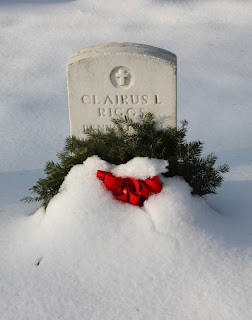Sainte-Mere-Eglise is one of four sister cities of
Gettysburg, Pennsylvania. What
connection does a small village in the Normandy region of France have with a
small town in south central Pennsylvania?
The answer of course is, history.
In June of 1992, a letter from Mayor Marc LeFevre of
Sainte-Mere-Eglise was presented to Mayor Francis Linn of Gettysburg, which
suggested that the two towns should form that relationship. LeFevre explained that both communities were important
in the history of their countries.
Gettysburg was famous for a pivotal battle of the American
Civil War and Sainte-Mere-Eglise was the first French city to be liberated by
Allied troops as a result of the D-Day Invasion of Normandy. He cited that General Dwight Eisenhower's
nexus to both in that President Eisenhower chose to purchase a home in
Gettysburg and that he was also the Supreme Allied Commander of the Allied
Forces which liberated his town. It was
also mentioned that the Marquis de La Fayette assisted the U. S. in the
American Revolution and two hundred years later, "...your soldiers
willingly came to France to restore our lost dignity and freedom."
 In a poignant portion of the letter LeFevre stated,
"Thirteen thousand young American soldiers were buried here in three
temporary cemeteries..." He further
added that those bodies which weren't repatriated were buried, "...at the Normandy American Cemetery
and Memorial located at Colleville sur Mer overlooking Omaha Beach."
In a poignant portion of the letter LeFevre stated,
"Thirteen thousand young American soldiers were buried here in three
temporary cemeteries..." He further
added that those bodies which weren't repatriated were buried, "...at the Normandy American Cemetery
and Memorial located at Colleville sur Mer overlooking Omaha Beach."
The offer was enthusiastically accepted by Gettysburg
officials and during the intervening years delegations from both cities have
visited each other. A warm, friendly and
respectful relationship has been achieved between both communities. It was reported that during the trip to
Normandy for the Fiftieth Anniversary of D-Day, the Gettysburg delegation
received emotional greetings of welcome and thank you from the locals residents
where ever they traveled. The French
have not forgotten the American sacrifices suffered in the liberation of their
country.
 Few people realize that the bond between Sainte-Mere-Eglise
and Gettysburg began to strengthen shortly after World War II, during the
repatriation of American war dead of which Mayor LeFevre spoke. The strength of that bond comes from the fact
that many of these dead came to their final rest in the Gettysburg National
Cemetery. Recent scholarship has showed
that at least twelve of those American heroes who died on June 6, 1944, on and
near the beaches at Normandy were re-interred in Gettysburg.
Few people realize that the bond between Sainte-Mere-Eglise
and Gettysburg began to strengthen shortly after World War II, during the
repatriation of American war dead of which Mayor LeFevre spoke. The strength of that bond comes from the fact
that many of these dead came to their final rest in the Gettysburg National
Cemetery. Recent scholarship has showed
that at least twelve of those American heroes who died on June 6, 1944, on and
near the beaches at Normandy were re-interred in Gettysburg. One of those soldiers was Private First Class Clairus L.
Riggs of Company B, First Battalion, One Hundred Sixteenth Infantry of the
Twenty-Ninth Infantry Division. He was
from Coalport, Clearfield County, Pennsylvania.
One of those soldiers was Private First Class Clairus L.
Riggs of Company B, First Battalion, One Hundred Sixteenth Infantry of the
Twenty-Ninth Infantry Division. He was
from Coalport, Clearfield County, Pennsylvania.
In the early morning hours of June 6, 1944, PFC Riggs was
being transported across the English Channel aboard the troop transport S.S.
Empire Javelin. At 0330 hours, the
landing craft containing Boat Team One of Company B was heading toward Omaha
Beach. Riggs carried a Browning
Automatic Rifle which is a light machine gun that was deployed in a squad of
men. At 0640 hours the ramp of the
landing craft was lowered in the surf off of Dog Green Sector. As the six foot two inch soldier stepped on
the ramp he was hit by enemy gunfire and fell into the water, dead.
Clairus made it back to the United States and rests in Gettysburg National Cemetery, section 2, grave number 308.

